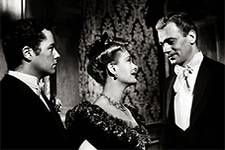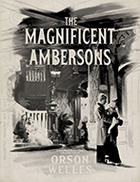The Magnificent Ambersons
|  Orson Welles’s second feature film, The Magnificent Ambersons, is one of Hollywood’s great tragedies both on-screen and off. Based on Booth Tarkington’s novel about the decline of a proud and wealthy Midwest family set against the rapid industrialization of the early 20th century, it was disastrously butchered by RKO, the studio that only a few years earlier had famously signed Welles to a contract to write, produce, direct, and act in two films over which he was given almost complete artistic control. It was a virtually unprecedented feat for a young artist (Welles was only 24 at the time); even though Welles was already a critical and commercial star of Broadway and radio, he had never stepped foot on a Hollywood set. Yet, the first film out of that contract was Citizen Kane (1941), which is now regarded as one of the pinnacles of Hollywood cinema, but at the time was a thorn for RKO because it challenged Hollywood orthodoxy in virtually every way and inflamed the ire of powerful media magnate Willian Randolph Hearst. Welles was in no way chastised by his experience with Kane, which Hearst sought to destroy and people booed him for at the Oscars. Instead, he delved right into his next project, an adaptation of Tarkington’s 1918 Pulitzer Prize-winning novel that he scripted himself, which is testament to how close he felt to the project. Ambersons was never going to be a conventional Hollywood project, with its focus on decline and familial tragedy, but it was also struck with an unfortunate case of bad timing, as its completion coincided with the U.S. entering World War II, at which point Hollywood immediately engaged in upbeat and patriotic films, not dark dramas about interpersonal, financial, and social collapse. As David Thomson notes in his book Rosebud: The Story of Orson Welles, “Ambersons was not suited to the moment. America was in the war summoning men, munitions and a positive attitude—there was nothing in Ambersons’ America to fight for (except, maybe, the capacity to see so deep into the soul and the hinterland).” The big hits that year were Yankee Doodle Dandy and Mrs. Miniver, the latter of which Winston Churchill declared to be worth a hundred battleships. This was not the first time Welles had adapted Tarkington’s novel, as he had previously produced and starred in a one-hour radio version for The Campbell Playhouse in 1939 (the novel had also been adapted as a film in 1925 titled Pampered Youth, the complete version of which has been lost). Welles liked to boast that Tarkington, who was one of the best known American novelists of his era, was a friend of his father’s and had based one the novel’s characters on him, although there is no evidence to back up such an assertion. Nevertheless, the story clearly meant a great deal to Welles, especially the way it depicted the Midwest of his own childhood, a nostalgia for which is evident in Welles’s voice-over narration. The film’s opening is a bravura walk-through of early 20th-century Americana, replete with changing clothing styles, courting rituals, and social dynamics. The central characters in the story are all members of the Amberson family. The familial patriarch, Major Amberson (Richard Bennett), has a son, Jack (Ray Collins), and a daughter Isabel (Dolores Costello). Isabel is married to Wilbur Minafer (Don Dillaway), whose spinster sister, Fanny (Agnes Moorehead), has become part of the family. The Minafer’s son, George, was a spoiled terror as a child and has grown up to be a pompous, arrogant, and entitled young man (Tim Holt). A great deal of the film’s dramatic tension revolves around the presence of Eugene Morgan (Joseph Cotton), an entrepreneur and inventor who, in his youth, was involved with Isabel and, now that he is a widower returned to town after a 20-year absence, would like to be again, especially after Wilbur passes away. George, ever the jealous and petty man, doesn’t want his mother getting involved with Eugene, even as he pursues Eugene’s daughter, Lucy (Anne Baxter). A great deal of the film unfolds in and around Amberson Hall, an enormous mansion that Welles had constructed on contiguous soundstages, making it one of the largest and most expensive sets ever built for a Hollywood film at that time. Lavishly appointed and gargantuan in size, the mansion becomes its own character as Welles’s nimble camera moves in and out of the various rooms, tracking characters as they mix and mingle during a lavish ball thrown in George’s honor or following George and Lucy as they make their way up the massive central staircase. When Kane cinematographer Gregg Toland proved unavailable, Welles selected Stanley Cortez to shoot the film. Cortez was under a seven-year contract at Universal, where he had primarily shot lower-budget films and worked on the B unit of larger productions, so working with Welles on Ambersons marked an enormous leap forward. He maintains much of the visual style that Welles used on Kane, particularly the deep-focus photography and emphasis on multiple planes of action, as well as fluid camera movements and extensive tracking shots, some of which surpassed anything that Welles had attempted in his previous film. At the same time, though, Ambersons is a decidedly more conventional film than Kane, with less emphasis on grandiose, grotesque, or Gothic imagery. It also runs along a conventionally linear plotline, eschewing the complex flashback structure that made Kane so innovative and challenging. As with that film, though, Welles elicits magnificent performances from his eclectic cast, which was composed of both Mercury Theatre veterans like Joseph Cotton, Agnes Moorehead, and Ray Collins; virtual unknowns like Anne Baxter; and offbeat choices like Tim Holt, who at the time was known almost exclusively from Westerns (Welles had seen him in John Ford’s Stagecoach, the film Welles had studied extensively to learn the art of film). Welles himself had played George in his radio version of Ambersons, but he was too large, too imposing a physical presence to play him on screen, which is why he cast an actor like Holt who was much smaller in scale, both physically and in terms of personality. Holt’s performance is quite perfect in this regard, as his George is always straining to be the alpha male, to show up everyone around him, even when it is clear that he doesn’t have the true standing to do so. The tragedy of the Ambersons is completely bound up in George’s pretensions and personal limitations—his final “comeuppance” at the end destroys him and everyone around him. By all rights, The Magnificent Ambersons should have been a worthy successor to Citizen Kane, further evidence of Welles’s bravura artistry. However, it was not to be, as Welles’s initial cut, which ran 132 minutes, was slashed by order of RKO executives to 88 minutes and padded with new footage and an awkward new ending after a sneak preview of Welles’s initial cut did not go as well as planned (RKO President George Schaefer described it in a letter to Welles as the worst experience in his 28 years in the film industry, although the audience was actually somewhat split, with 72 marking their card unfavorable while 53 marked their card positive). Welles was in Rio de Janeiro at the time, shooting footage for an ambitious documentary about Brazil for the U.S. Office of Inter-American Affairs. He had entrusted his editor, Robert Wise, with completing the film’s editing after he left the country, but Wise and assistant director Freddie Fleck were engaged by RKO to recut the film, and the studio dumped the excised footage, despite pleading from Wise to save it. The opening third of the film was left largely intact, but as it moves past the midway point you can really start to feel the alterations, as narrative rhythms are disrupted, the pacing feels increasingly odd, and plot points come and go too quickly. Beautiful tracking shots are truncated or broken up, and entire scenes were discarded, including what has been purported to be one of Welles’s finest cinematic achievements, a lengthy tracking shot of George wandering through the deserted Amberson mansion one last time. Welles, despite the damage being done to his film, naively believed that he would be able to continue work on it once he returned to the U.S., but instead RKO rushed it into a meager theatrical release a few months later. It played at two theaters in Los Angeles at the bottom of a double-bill featuring the Lupe Velez haunted house comedy Mexican Spitfire Sees a Ghost (1942). A duplicate print of the rough cut had been shipped to Welles in early 1942, and optimists are still holding out hope that it is somehow still there, tucked away in a closet or attic waiting to be discovered, even though film historian Robert Carringer discovered correspondence from late 1944 and early 1945 in which RKO instructed the “Brazilian office” to “junk” the print. Assuming that directive was followed, it is likely that we will never see Welles’s version of The Magnificent Ambersons. It is fairly safe to say that anyone who saw it in 1942 has passed away, and even if there are a few still alive, they won’t be around much longer, and whatever memory they had of Welles’s great film, the one that very well might have been considered a greater achievement than Citizen Kane, will die with them. And, while what we have today is a shadow of Welles’s original vision, it is still an often masterful shadow, a film of great moments and greater compromise that will forever remain one of cinema history’s most tantalizing and distressing “what if’s.”
Copyright © 2018 James Kendrick Thoughts? E-mail James Kendrick All images copyright © The Criterion Collection | |||||||||||||||||||||||||||||||
Overall Rating: 


 (3.5)
(3.5)


